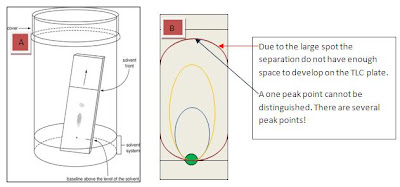Cladosporium Bio Assay in Thin Layer Cromatography
.jpg)
Cladosporium bio assay is another identification method specific for the detection of antifungal compounds. Anti-fungal compounds are the substances that can act against fungi. In this assay Cladosporium spp. are used because of the characteristic features of their mycelium and the spores. The mycelium and spores of Cladosporium sp. is dull black in colour. This feature detects the anti-fungal compounds in contrast. The spores of Cladosporium sp. (Microscopic view) The mycelium of Cladosporium sp. First a chromatogram was performed with the substances that are having different anti-fungal activities. Next a suspension of conidia of Cladosporium sp. is prepared. Then this is sprayed over the TLC plate. The TLC plate is then incubated. After incubation some areas can be seen in white where as rest of the whole area is black in colour. The black colour is due to the development of conidia of Cladosporium sp. White areas are the places where anti-fungal compounds a...


